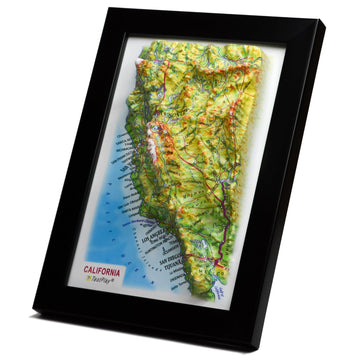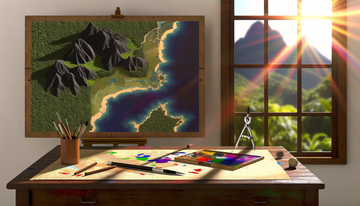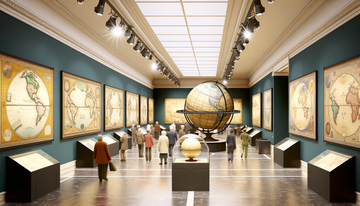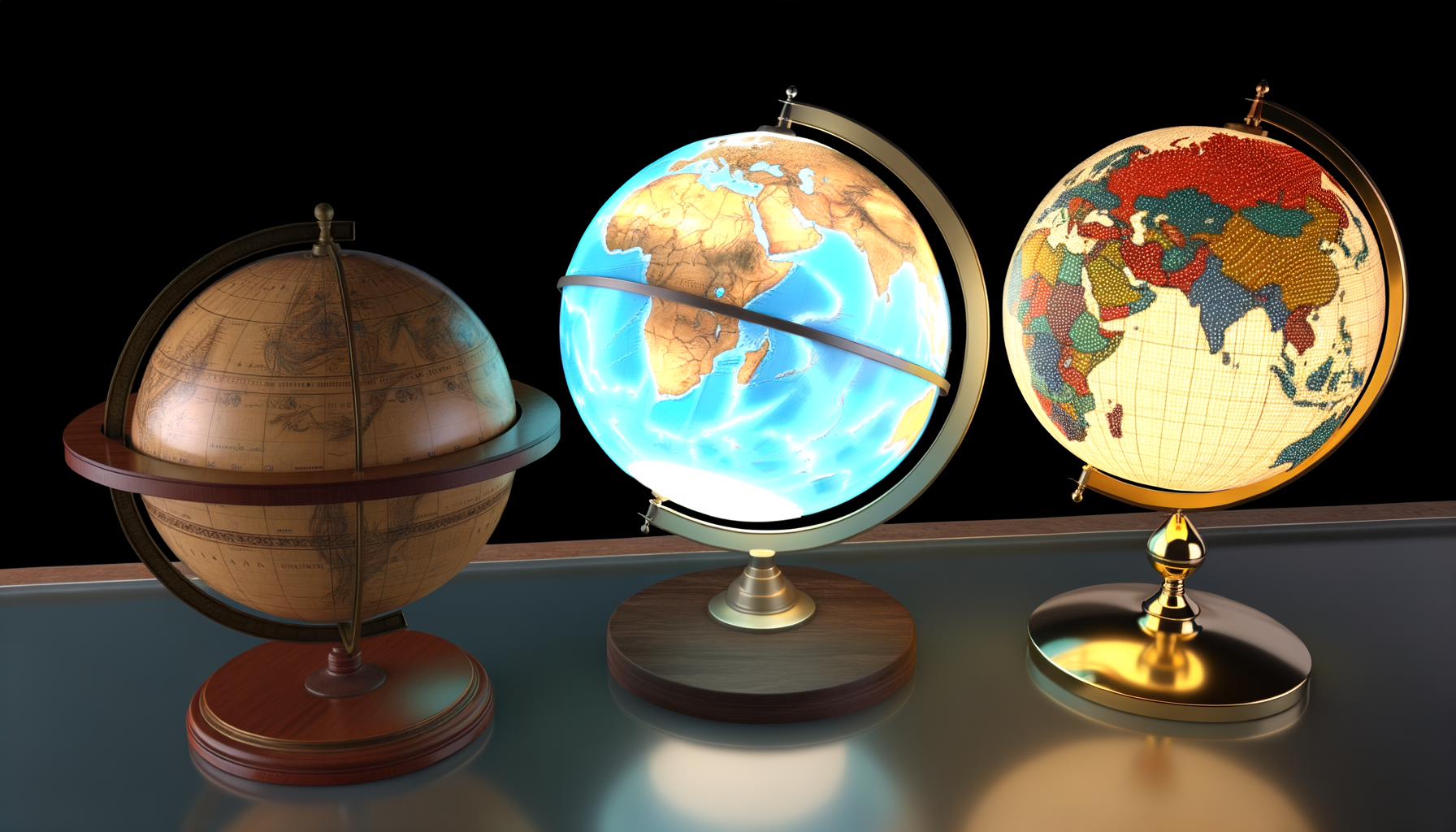Choosing the Perfect Globe: A Comprehensive Guide to Illuminated, Antique, and Other Features
Introduction: Navigating Your World, One Sphere at a Time
The world is a vast and wondrous place, and for centuries, the globe has served as a captivating miniature representation of our planet. More than just a tool for geography, a globe is a piece of art, a source of inspiration, and a window into different cultures and landscapes. However, stepping into the world of globes reveals a surprising variety, each with its own unique characteristics and appeal. Choosing the right one can feel like a daunting task with options ranging from glowing spheres to vintage-inspired masterpieces.Are you seeking a globe for educational purposes, a stunning decorative piece for your home or office, a tool for planning future travels, or perhaps a unique gift? The ideal globe for you depends heavily on its intended use and the features you prioritize. Understanding the different types of globes available is the first crucial step in making an informed decision.
This authoritative guide is designed to demystify the process, breaking down the primary features that differentiate globes. We will explore the allure of illuminated globes, the timeless elegance of antique and decorative styles, and the foundational qualities of standard contemporary models. By the end of this post, you will have a clear understanding of what each type offers and how to choose the perfect globe to bring the world into your space.
Why Choose a Globe? More Than Just Decoration
Before diving into specific features, it is helpful to consider the fundamental value a globe brings. In an age dominated by digital maps and GPS, the physical globe retains a unique importance. It offers a tangible, three-dimensional perspective of the Earth that a flat map simply cannot replicate. Observing continents, oceans, and countries in their true relative size and position on a sphere provides an intuitive understanding of global geography.For educational purposes, a globe is an indispensable tool. It helps students visualize distances, understand concepts like latitude and longitude in a practical way, and grasp the relative sizes of landmasses and bodies of water without the distortion inherent in flat projections. It is a foundational element for learning world geography, making abstract concepts concrete and engaging.
Beyond education, globes serve significant decorative and inspirational roles. A well-chosen globe can become a focal point in any room, adding a touch of intellectual curiosity, wanderlust, and sophisticated style. It can spark conversations, evoke memories of travels, and inspire future adventures. Whether placed on a desk, bookshelf, or standing proudly in a living area, a globe makes a statement about one's appreciation for the world.
Unveiling the Features: Types of Globes Explained
The most significant distinctions between globes often lie in their core features, which dictate their appearance, functionality, and primary appeal. Let us explore the characteristics of the most popular types.The Luminous World: Illuminated Globes
Illuminated globes are perhaps the most dynamic and visually striking type available today. These globes contain a light source inside the sphere, allowing them to glow from within. This feature dramatically transforms their appearance and adds layers of functionality and aesthetic appeal. The illumination can range from a soft, ambient glow to bright light that highlights specific details.Educational Benefits of Illuminated Globes
One of the key advantages of an illuminated globe, particularly those designed with dual mapping, is their enhanced educational value. Many illuminated globes feature "dual mapping" or "two-in-one" cartography. When the light is off, they might display political boundaries, showing countries, capitals, and major cities.However, when the light is switched on, the cartography changes to reveal physical features such as mountain ranges, deserts, river systems, and ocean depths. This provides a powerful visual representation of both the political and physical geography of the Earth, offering a comprehensive learning experience within a single sphere. This dual view makes them exceptionally versatile for students and anyone keen to understand the Earth's diverse surface.
Aesthetic Appeal and Ambiance
Beyond education, the aesthetic appeal of an illuminated globe is undeniable. When lit, it becomes a captivating source of light and interest in a room, creating a warm and inviting ambiance. The glowing sphere can highlight the vibrant colors and intricate details of the map in a way that a non-illuminated globe cannot, making it a stunning decorative piece both day and night.They can serve as unique night lights in children's rooms or add a sophisticated glow to studies, living rooms, or offices. The ability to transform its look with the flick of a switch adds an element of versatility that is highly appealing to many buyers. The subtle illumination can also make the details on the map easier to read in low light conditions.
Power Source and Lighting Types
Illuminated globes typically require a power source. Most commonly, this is a power cord that plugs into a standard wall outlet. Some modern designs might feature USB power options or even battery power for greater portability, although corded models usually offer brighter and more consistent illumination. The light source itself is typically an LED bulb, which is energy-efficient and long-lasting, or sometimes a traditional incandescent bulb.When choosing an illuminated globe, consider the placement relative to power outlets and the desired brightness and warmth of the light. The type of bulb can affect the color temperature of the light and how the colors on the globe appear. Ensure the power cord length is suitable for your intended location or explore battery-powered options if flexibility is paramount.
A Touch of History and Elegance: Antique and Decorative Globes
Antique and decorative globes prioritize style, craftsmanship, and often a vintage aesthetic over strict up-to-the-minute geographical accuracy (though modern antique-style globes use current maps). These globes are designed to evoke a sense of history, adventure, and classical scholarly pursuit. They are highly sought after for their beauty and ability to complement various interior design styles, from traditional to eclectic.Defining "Antique" and "Antique Style"
It is important to distinguish between a true antique globe and a modern globe made in an "antique style" or "antique finish." A true antique globe is a historical artifact, often dating back many decades or even centuries. Its value lies in its age, rarity, historical cartography (showing past political boundaries), and craftsmanship. These are collectible items, often found in antique shops or auctions, and may require specialized care.An antique *style* or antique *finish* globe is a newly manufactured globe designed to look old. This is achieved through coloring techniques on the map (often yellows, browns, and sepia tones), choice of materials for the stand and meridian (wood, brass-plated metal), and sometimes simulated aging effects. These globes use current geographical information but present it with a vintage aesthetic. This style offers the look of history without the fragility or cost of a genuine antique.
Decorative Potential and Craftsmanship
The primary appeal of antique and decorative globes is their significant decorative potential. They serve as sophisticated statement pieces that enhance the character of a room. The finishes on the map, the material and design of the stand (often turned wood, ornate metalwork), and the overall aesthetic contribute to their charm. These globes are often chosen to match specific furniture styles or decor themes.Craftsmanship is a key consideration. High-quality antique-style globes feature carefully applied gores (the segments of the map that make up the sphere), detailed printing, and well-made stands and meridians. Materials like solid wood, polished brass, or sturdy metal contribute to their substantial feel and appearance. Cheaper versions might use plastic stands or less detailed map finishes.
Cartographic Styles: Historical vs. Modern Maps
While most modern antique-style globes use current political and physical geography presented in an aged color palette, some decorative globes might feature genuinely historical maps or artistic interpretations. If you are buying an antique *style* globe for decorative purposes, ensure you know if the map is current or historical, especially if you also plan to use it for geographical reference. A globe with a historical map is a fascinating piece of history but will not help you locate current countries or cities.For the collector or history enthusiast, a globe with a truly historical map can be incredibly interesting, showing vanished empires, different country names, and historical trade routes. However, for general use and current reference, a modern map with an antique *finish* is usually preferred. Always check the description to understand the cartography style.
The Classic View: Standard and Contemporary Globes
Standard or contemporary globes represent the most common and widely recognized type of globe. These globes focus on presenting current geographical information with clarity and accuracy, typically using vibrant, true-to-life colors for political boundaries and physical features. They are the workhorses of the globe world, found in classrooms, libraries, and many homes.Focus on Detail and Clarity
The primary strength of standard contemporary globes lies in their clear and detailed cartography. They are designed for readability and geographical accuracy. Political globes use different colors to delineate countries and show capitals, major cities, and borders. Physical globes use shading and color variations (like greens for lowlands, browns for mountains) to depict topography and natural features. Many globes combine both political and physical information.The names of countries, cities, oceans, rivers, and mountains are typically printed in clear, legible fonts. The accuracy of the map is usually kept up-to-date with political changes, although the frequency of updates can vary depending on the manufacturer and model. For anyone needing a globe for educational study, geographical reference, or planning travel routes based on current information, a standard contemporary globe is an excellent choice.
Durability and Practicality
Standard globes are often built with practicality and durability in mind, especially those intended for educational settings. The globe sphere is commonly made from sturdy plastic or cardboard, covered with printed paper gores. The stands and meridians can be made from plastic, metal, or wood, designed to support the sphere and allow for smooth rotation and tilting.These globes are generally robust enough for regular handling and use. They come in a wide range of sizes and styles, from small desktop models perfect for a student's desk to larger floor models suitable for a library or office. Their straightforward design means they are typically less expensive than illuminated or high-end decorative globes, offering excellent value for their primary function of displaying the Earth's geography.
Beyond the Surface: Key Factors When Choosing Your Globe
While the main feature type (illuminated, antique style, standard) is a major decision point, several other factors are crucial to consider before making your final choice. These elements affect the globe's usability, appearance, and suitability for its intended location and purpose.Size and Scale
The physical size of the globe, specifically its diameter, significantly impacts its portability, the amount of detail it can display, and its visual presence in a room. Globes range from miniature novelty sizes to massive floor-standing models.Desktop vs. Floor Models
Globes are broadly categorized into desktop and floor models. Desktop globes are designed to be placed on a table, desk, or shelf. Their diameters typically range from around 4 inches (10 cm) to 12 or 16 inches (30-40 cm). They are convenient for close study and fit easily into smaller spaces.Floor globes, in contrast, are mounted on tall stands, placing the sphere at a comfortable viewing height while standing or seated nearby. Their diameters are usually larger, starting from around 12 inches and going up to 30 inches or more. Floor globes make a grand statement and are ideal for larger rooms or areas where they serve as a central point of interest. Consider the available space and how you intend to use the globe when deciding between these styles.
Diameter and Detail
There is a direct correlation between the globe's diameter and the amount of detail its map can realistically display. A larger diameter sphere provides more surface area, allowing for the inclusion of more cities, rivers, smaller political entities, and finer topographical details. A small globe might only show major countries and capitals, while a large one can include thousands of place names and intricate geographical features.If your primary use is detailed study or geographical reference, opting for a larger diameter globe will provide a much more satisfying experience. For purely decorative purposes or general overview, a smaller or medium-sized globe might suffice. Always check the scale indicated on the globe (e.g., 1 inch equals X miles or a ratio like 1:40,000,000) to understand the level of detail it can realistically show.
Cartography and Information
The map printed on the globe's surface is its informational core. The style and content of this cartography are critical, depending on whether you need a tool for current reference, historical insight, or visual appeal.Political vs. Physical Maps
Globes typically feature either political or physical maps, or sometimes a combination. A political map emphasizes national borders, countries, states or provinces, capitals, and major cities, usually distinguished by different colors for each country. This type is essential for understanding political geography and current world divisions.A physical map focuses on the Earth's natural features, using colors and shading to show elevations (mountains, plateaus, plains) and depths (oceans, trenches). This is valuable for understanding topography, climates, and environmental zones. Many modern globes, especially illuminated ones, offer dual mapping that switches between political and physical views. Decide which type of information is most important for your intended use.
Up-to-Date Information
The political landscape of the world can change, though major shifts are less frequent now than in some past eras. If geographical accuracy for current events and boundaries is paramount, ensure the globe features up-to-date cartography. Reputable manufacturers regularly update their map databases. While a globe bought today will likely be current, very old standard globes might show outdated political divisions. Always check the copyright date or cartographer's information if currency is a major concern. For decorative or antique-style globes, historical accuracy or a vintage *look* might be the goal, where outdated maps are part of the charm.Legibility and Detail
Regardless of map type, the clarity and legibility of the text and features are vital. Small font sizes, cluttered mapping, or poor printing quality can make a globe difficult to use. Examine the map closely (if shopping in person) or look for high-resolution images online to assess the readability of place names and the crispness of the lines and colors. The level of detail should be appropriate for the globe's size; trying to cram too much information onto a small globe harms legibility.Materials and Construction
The materials used for the globe sphere, base, and meridian affect its durability, weight, appearance, and cost. Understanding these can help you assess the quality and longevity of a globe.Globe Sphere Material
The sphere itself is typically made from molded plastic or compressed cardboard. Plastic is durable and often used for illuminated globes or those intended for heavy use. Cardboard spheres, covered with printed paper gores, are common in standard and many decorative models; the quality depends on the thickness of the cardboard and the precision of the gore application. High-end or historical reproductions might use other materials, but plastic and cardboard are the most common.Base and Meridian Materials
The base supports the sphere and provides stability, while the meridian is the half-circle or full circle ring that the sphere rotates within, marked with degrees of latitude. These components are commonly made from plastic, metal (steel, brass, aluminum), or wood.Plastic bases and meridians are often found on educational or lower-cost globes; they are lightweight and durable but can lack the visual appeal of other materials. Metal meridians and bases offer robustness and a classic look, often seen in higher-quality standard and antique-style globes. Wood bases and meridians (often turned or carved) add warmth, elegance, and a traditional feel, frequently paired with antique-style globes. The weight and quality of these materials contribute significantly to the globe's overall feel and stability.
Durability
Consider where the globe will be placed and who will be interacting with it. A sturdy base and durable sphere are important if it is for a child's room or a high-traffic area. For a decorative piece placed out of the way, fragility might be less of a concern. Illuminated globes with internal wiring require careful handling. The quality of the stand and the secureness of the sphere's mounting also affect how well the globe will hold up over time with rotation and handling.Budget Considerations
Globes vary widely in price, from under fifty dollars for small plastic desktop models to thousands for large, handcrafted floor globes or genuine antiques. Your budget will naturally influence the size, features, and quality you can realistically consider.Price Ranges for Different Types
Standard desktop globes are generally the most affordable. Illuminated globes tend to be moderately priced, with the cost increasing with size and the sophistication of the dual mapping or lighting features. Antique *style* globes can vary significantly depending on the quality of materials and craftsmanship, ranging from relatively inexpensive decorative items to high-end pieces approaching the cost of larger standard or illuminated globes. Genuine antique globes are collectibles and priced based on age, rarity, condition, and provenance, potentially reaching very high values.Value vs. Cost
When setting a budget, consider the value you expect from the globe. If it is a primary educational tool, investing in a larger, highly detailed, and potentially illuminated model might be worthwhile for its enhanced learning capabilities and longevity. If it is primarily a decorative item, balance aesthetic appeal with cost, remembering that quality materials and craftsmanship come at a higher price but offer better durability and visual impact. Define your primary use case and allocate your budget accordingly to find the best value for your needs.Making Your Decision: Matching the Globe to Your Needs
Bringing together the different types and features discussed, here is how to approach your decision based on common purposes.For the Educator or Student
1. Prioritize clear, accurate, and up-to-date cartography. Look for current political boundaries and legible place names.
2. Consider a dual-mapping illuminated globe. The ability to switch between political and physical views offers comprehensive learning.
3. Choose an appropriate size. A desktop globe between 8 and 12 inches in diameter is usually sufficient for individual study, offering a good balance of detail and manageability. Larger sizes are better for group learning.
4. Value durability. Opt for sturdy materials, especially if the globe will be handled frequently.
An 8 to 12-inch illuminated globe with dual mapping on a durable plastic or metal base represents an excellent choice for educational purposes, providing both political and physical geography with enhanced visual clarity.
For the Decorator or Collector
1. Focus on aesthetic appeal and craftsmanship. Consider the style of the stand, the colors of the map, and the overall finish.
2. Explore antique style and high-end standard globes. These often feature richer materials like wood and polished metal, contributing to their decorative value.
3. Consider size and placement. A large floor globe can be a dramatic centerpiece, while a smaller desktop globe might accent a bookshelf or table. Choose a size that complements your space.
4. If seeking a true antique, consult experts. Understand the provenance, condition, and historical significance.
A floor-standing antique-style globe with a solid wood base or a beautifully crafted illuminated globe with a unique map finish could be ideal decorative choices, offering significant visual impact and reflecting personal style.
For the Traveler or Planner
1. Ensure current and detailed cartography. You need accurate names, cities, and boundaries for planning trips.
2. Consider size based on usage. A medium to large desktop globe (12 inches or more) provides enough detail to locate specific cities and routes.
3. Legibility is key. Make sure place names are easy to read without strain.
4. Physical features can be helpful. A globe showing topography can inform travel choices, especially regarding terrain or climate zones.
A 12-inch or larger standard or illuminated globe with clear, up-to-date political and perhaps physical mapping offers the necessary detail and readability for trip planning and satisfying your wanderlust from home.
Conclusion: Your World, Your Choice
Selecting a globe is a personal journey, guided by your intended use, aesthetic preferences, and practical considerations like size and budget. Whether you are drawn to the vibrant glow of an illuminated sphere, the timeless charm of an antique-style piece, or the straightforward utility of a standard contemporary model, there is a perfect globe waiting to connect you more deeply with the planet we inhabit.Take the time to consider the features that matter most to you – is it educational functionality, decorative impact, historical appeal, or simply a clear, accurate representation of the world? By evaluating the types of globes and the factors discussed in this guide, you are well-equipped to make an informed decision that will bring the world into your home or office in a way that is both beautiful and meaningful.
A globe is more than just geography; it is an invitation to explore, to learn, and to appreciate the incredible diversity of our Earth. Choose wisely, and let your new globe inspire countless journeys, real and imagined.




